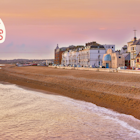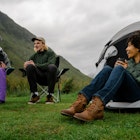
Oct 14, 2024 ā¢ 5 min read

Hereās what you need to know before you dive into Edinburgh Ā© matthi / Shutterstock
With its grand castle and famous festival, Edinburgh is a tourist magnet. But Scotlandās capital isnāt just a collection of big-ticket sights. Set on a series of extinct volcanoes and blessed with chasm-like medieval alleys and grand civic squares, Edinburgh is a stunner with substance.
Thereās history around every sandstone-hewn corner, of course, but youāll also find vibrant life in its parks, pubs and suburbs. Edinburgh isnāt just worth visiting, itās worth throwing yourself into. Hereās what you need to know before you dive in: when to go, what to pack, the slang, the smells and the banknotes.
Edinburgh's airport is 8 miles (13km) away. Buses (cheaper), trams (quicker when the roads are busy) and taxis (good for door-to-door drop-offs) connect the terminal with the city center.
Train passengers roll into Edinburgh Waverley ā travelers coming from England will get gorgeous coastal views on the way up. Buses arrive at St Andrewās Square in the New Town, just north of the center.
Summer, when the days are long and bright and the winds are generally docile, will suit most visitors best. But if you donāt mind a spot of dreich (dismal) weather, come in the colder months, when you can mix warm pubs and museums with bracing strolls along atmospheric streets.
The worldās biggest arts festival, the Edinburgh International Festival, takes over the city every August. If youāre going, book your accommodation months in advance and be ready to book the biggest shows early too. If youāre not, avoid August. Things also get pretty busy around Hogmanay (the run-up to New Year), but the madness is shorter-lived.
The earlier you book your accommodation the better, especially during festival time. The biggest shows, including the Tattoo, should be booked well in advance too. The Edinburgh City Pass is worth a look if youāre also going to hit attractions such as the Castle and Leithās Royal Yacht Britannia ā it includes access to the fun city bus tours too.
Beyond that, booking online a day or so before you go is a good idea for the castle ā you can save money and waiting time.
Youāll need a jacket whenever youāre visiting. Edinburgh rarely gets that cold, but it can change from bright sunshine to rain-lashed darkness in a heartbeat. Youāre likely to do a fair bit of walking, so a pair of comfy shoes is important. Thereās no need to pack anything particularly formal.

Central Edinburgh is a city divided. But itās not any ill feeling that keeps the city apart ā instead a valley containing the elegant Princes Street Gardens and Waverly Station separates the Old and New Towns. The Old Town is the medieval quarter, where packed tenements rise high and cobbled streets and wynds (alleys) stretch down from the famous Royal Mile. The New Town (around 250 years old, everything being relative) has airy boulevards and clipped squares along an orderly grid.
Further out are districts including the West End (fairly smart), Leith (the rough-cut setting of Trainspotting, now steadily gentrifying) and the Southside (low-key and studenty).
Take a day for a whistle-stop tour of the Royal Mile and a ramble around the Castle, or take two to get a sense of what the Old and New Towns have to offer. Four days or more will give you a proper feel for the city, heading north to the former port of Leith and west to the Gallery of Modern Art, as well as ticking off all the big sights in the center.
Scotland has its own banknotes, but English notes are accepted everywhere in Scotland. (Youāll find a few shops in England that donāt repay the favor.) Card and contactless payments are now more common than cash, and they're the easiest way to pay on public transport too ā if you use cash on a bus, youāll need exact change, or a is a good alternative.
Edinburghās gay scene is centered on the āPink Triangle,ā just northeast of Princes Street. CC Blooms is the mainstay, with (fairly expensive) food in the day and cabaret and DJs at night. Down the road in Abbeyhill, the Regent is a laid-back alternative. Same-sex marriage was legalized in Scotland in 2014.
āOld Reekieā is one of Edinburghās most enduring nicknames. It dates from the 17th century, when the Old Townās narrow, tall streets, combined with the Nor Loch (a stagnant pool where Princes Street Gardens now sits) created a notorious odor that mixed smoke and effluent. These days, Edinburgh smells much like any other city, although the West End sometimes has a slight boozy fug from the brewery.

It's hilly, but walking is the best way to get around Edinburgh ā youāll pass unexpected views and get a feel for the cityās rhythms. If youāre heading right across town, a cab (try Central Taxis) or ride-sharing app (Uber is the big one) isnāt a bad bet. Thereās no subway, but trams connect the city center and West End with the airport, and buses are also helpful for heading to Leith or the Southside.
If you meet someone in a social setting, an informal āhiā or a handshake are the usual greetings. Youāre unlikely to inadvertently cause offense, though subjects like politics and religion are generally avoided in small talk. Scottish independence and Brexit can inspire passionate responses too.
Remember that Edinburgh is in Scotland, which is a part of Britain, but youāre definitely not in England ā while lots of English people happily make Edinburgh their home, the England football team is traditionally booed with enthusiasm.
As a cosmopolitan city, Edinburgh is used to a range of accents. But you may not recognize every word you hear ā take, for example, haar (a sea fog), Jambos (supporters of local club Hearts), Hibbies (hy-bees, supporters of city rivals Hibernian), Weegies (Glaswegians) and salt ān sauce (a vinegary and delicious condiment for chips). And you should ken (know) that Cockburn Street is pronounced āCoe-burnā and Edinburgh itself is āEdin-bru,ā or even āEmbra.ā
Rules here are the same as elsewhere in Britain and Ireland ā one person usually orders for your group at the bar, paying for the āroundā of drinks and bringing them back to the table. Everyone else then takes turns to get the round. Smarter bars may have table service, and almost everywhere will be able to offer a tray if youāve lots of drinks to carry.
Most places take cash, although card or phone payments are more common. Pubs stay open later than south of the border ā usually until midnight or 1am.
Tipping is only really required for table service in a restaurant (10% to 15%), although locals often round up taxi fares. If a hotel porter helps with your luggage, a tip of a pound or two per bag is standard.

Edinburgh is relatively safe. Pub-packed areas like the Cowgate (Old Town), Rose Street (New Town) and Lothian Road (West End) get lively on Friday and Saturday nights, but serious trouble is rare. Calton Hill offers good views during the day but is best avoided at night. Take usual precautions for a city, and use recognized ride-sharing apps or black cabs if in doubt at night.
Street scams are also uncommon, but watch your step as you explore: The sloping cobbles of the Old Town are slippery when wet. And when crossing roads, remember that traffic drives on the left.
Most modern hotels and attractions are accessible for travelers with disabilities, but many older buildings ā including guesthouses and some pubs and restaurants ā lack ramps and lifts. The New Town, with its wide streets, is more straightforward for wheelchair users than the steep, sometimes cobbled streets of the Old Town. Tourism body VisitScotland has a to accessible accommodation.
Oh yes. Edinburgh tap water is safe to drink ,and you can request it for free with your meal in a restaurant. The regionās water is soft (low in dissolved minerals), giving it a fresher taste than water from much of the UK.


Oct 14, 2024 ā¢ 5 min read



Jan 2, 2024 ā¢ 7 min read

Dec 5, 2023 ā¢ 7 min read




May 22, 2023 ā¢ 6 min read